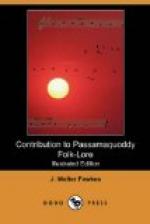The Raven was told to build a wigwam for Cooloo, who was chief. Pogump (Black Cat) went to see the chief, and killed him with the powder. Black Cat went to see Pookjinsquess; he scattered a ring of powder around her wigwam, and then set it on fire. It blazed up and ignited the wigwam, burning up the old woman Pookjinsquess; whose ashes, blown about by the winds, made the mosquitoes.[19]
[Footnote 19: In this manner he obtains his revenge. Dr. Boas tells me he has heard a similar story of the origin of the mosquitoes on the West Coast.]
Leland, in his version of this story, represents the Black Cat as identical with Glooscap,[20] and the Sable as a boy who had a flute by which he could entice to himself all the animals. The story of the sticks is similar, but the cutting up of the serpent is not mentioned. He says that Black Cat, who is preparing his arrows, and will return and destroy all, is Glooscap, who in another story kills the Snake, cuts him in fragments, and invites all the animals to eat him. The Turtle, the grandfather (adopted), arrives last, and only gets the blood for his share.
[Footnote 20: Mrs. Brown writes me that the Black Cat referred to is not identical with Glooscap. “There were very many of these mythological personages,” she says, “who were able to do things as wonderful as Glooscap, but they were not of his nature. He worked for good, they for selfish purposes.”
Mr. Leland’s work exhibits throughout want of exactness in recording just what the Indians told him. It is in deductions and explanations that error is liable to arise. A story made up from the recital of several Indians is likely to exhibit their attempts to explain doubtful parts of the story.]
A STORY OF LEUX.
A story of the old time. In winter, while travelling, Leux met a number of wolves, which were going in the same direction that he was. At nightfall the old wolf built a fire and gave Leux supper. He gave him skins to cover himself while he slept, but Leux said that the fire was so warm that he did not need or wish a covering. At midnight Leux awoke and was almost frozen with cold. The next morning Leux was obliged to part with the wolves.[21]
[Footnote 21: It would seem, from Leland’s account, that the wolf admired Leux greatly because he cared so little for the cold or their care.]
The old wolf said, “How far are you going?” Leux answered, “Three days’ journey.” The wolf said then, “I will do for you the very best thing I can. I will give you three fires, one for each night.” The wolf told him to gather some dry wood, put it in a pile, jump over it, and it would burn.[22]
[Footnote 22: It was possible that the wolf gave him some charm or medicine with which to accomplish this.]




